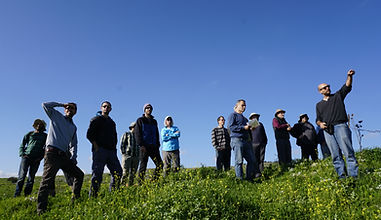
Training
Our educational program consists of class, lab and field courses that explore multiple aspects related to spatial, regional and landscape archaeology from both global and local (Levantine) perspectives. The program incorporates the study of theoretical frameworks used in research of places and landscapes, lab work centered on GIS applications to archaeological research, and field training in survey methodologies and collection of spatial and environmental data.





Introductory undergraduate course to geographical and spatial aspects of archaeological research in global and Levantine perspective, including an introduction to archaeological surveys – history of research, survey goals, methodology and applications – and to central concepts of spatial analysis in archaeology. The course incorporates two days of archaeological surveys and a one-day fieldtrip devoted to regional analysis and landscape archaeology.
This practical, hands-on course trains both graduate and undergraduate students in basic GIS applications in archeological research. The course is centered around the construction of individual GIS projects focusing on the concept of Site Catchment Analysis, and incorporates acquisition and production of environmental and cultural data layers (both raster and vector), refinement and georeferencing of spatial information, and spatial analyses using tools that examine distribution and proximity, viewshed and cost, boundaries and land use patterning.
Every other year, we hold a 4-day field campus in a selected region, devoted to the study of human-environment interactions in their regional context. Regional campuses conducted so far include the Negev Highlands (2022), Judean Desert (2020), and Golan Heights (2018). Each campus traces the regional patterns of human activity throughout the Holocene in relation to the environmental characteristics of the region, through direct experience of regional landscapes and visits to numerous archaeological sites of different types and periods.
Archaeological research of natural caves is generally associated with prehistoric hunter-gatherer societies. Following the Neolithic Revolution, cave use patterns underwent significant changes and caves began to be exploited for a variety of extramural activities, including burial, resource procurement, ritual and refuge. The course revolves around the study of ethnographic and archaeological records associated with caves used by complex societies, with specific emphasis on morphologically-composite caves and the chronological, functional, social and cognitive aspects of human activities in such caves in a global and Levantine perspective.
43787
Regional Archaeology: From Theory to Practice
This MA course, taught with Prof. Gideon Shelach-Lavi, discusses the theoretical principles that underlie the study of regions in world archaeology, and addresses related methodologies such as systematic regional surveys, GIS analysis of settlement and land use patterns, and the implementation of geographic models to regional archaeological analysis.
In this MA course, taught with Prof. Gideon Shelach-Lavi, we investigate human movement through the environmental, physical and material aspects of paths, trails and roads. We also look at obstacles that prevent or hinder movement – natural as well as artificial barriers such as walls and political borders – and the ways people adapted in order to overcome, bypass or confront these obstacles.
The course revolves around the concept of cultural landscapes, using Landscape Archaeology and phenomenological and sensual approaches in archaeological theory in order to reconstruct social and ideological trajectories among Levantine Bronze Age societies. The main questions examined are how did Bronze Age people construct and experience places and landscapes in all spatial levels (at home, on the street, in public spaces and in the open), and how did Bronze Age societies use natural and cultural landscapes to shape and maintain ideologies and lifeways.